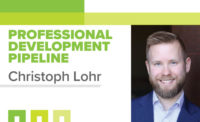In my last column, we discussed #growthmindset and how it is necessary to take intentional steps during your career (and life) to improve. Many steps taken to learn and grow require only time and intentional effort — volunteering on society boards; taking on new and challenging projects; or taking part in a corporate Toastmasters Club. These kinds of growth opportunities don’t cost you anything.
But one thing I have observed is our industry tends to not spend as many dollars on training as others, even though our industry is one of the most nuanced and technical out there. At times, I think we put too much weight on experience and not enough on deliberate training. And I think we miss out on some real growth as a result.
A story
I was recently listening to an audiobook by the Great Courses on investing for your retirement. One of the most interesting chapters was one I wasn’t expecting: Investing in yourself. In that chapter, the author spoke about spending money to allow time to develop your own human capital. Some examples were interesting to me: The author spoke about how they often did a lot of household tasks on their own, but sometimes would hire assistance for a household task to give them time to focus on a project, take a class or develop themselves in some other way. Peter Drucker famously said, “There are two types of learners: Readers and listeners.” It’s worth figuring out which type of way you learn best and align your learning opportunities to that method. (Manager tool tip: It’s also a good idea to figure out which type your boss is and give them information in the way they prefer).
If you are a reader, read books! If you aren’t a reader, read books! Several friends, colleagues and business associates of mine who are engineers have told me they “don’t read,” “don’t have time to read” or some similar sentiment. Worth noting here is that the average CEO in the United States reads 60 books per year. Yes, you read that correctly. The average CEO reads 60 books per year. That means some of them read more. Bill Gates, a CEO and “engineer,” reads about 50 books per year. Assuming $20 a book, that equates to more than $1,000 spent — on books. (And, yes, they purchase them because they also talk about how they mark the books up. You generally do not do that with library books). Also, CEOs on average work almost 60 hours per week. What is your excuse?
Books, however, are just one of many paths to reading: You can read industry publications (like this one) or journal articles. Often, you can get more practical/technical information this way. But there is a side benefit: The authors are typically more accessible. Almost every author of any industry article has an email as part of their signature. Here is a great opportunity to put yourself out there, reach out and develop a new technical resource for yourself.
Books and periodicals are just the lowest hanging fruit. Education most often occurs in the classroom. Classes can come in various shapes, sizes and dollar amounts:
-
$0 to $50: Your local ASPE, ASSE, IAPMO, etc., seminar. Cost is typically $0-$50 per trip. Some chapters have sponsorships that cover the cost. Some engineer’s employers pay for the class; others don’t, but either way, each month (typically), you have an opportunity to learn something and network with others in your field — keeping in mind that our industry, like so many others, lives by the mantra, “It’s not what you know, but who you know.” Really the only thing you shortchange by not attending such an event is yourself and your organization. Webinars could fall under this criteria and, yes, even on a webinar, there are opportunities to network if you get a little creative (e.g. use the chat function). If you hear an interesting talk, reach out to the speaker. Ask the speaker or the organization to connect you with someone based on something that was discussed.
-
$100-$800: Certifications such as the CPD, ASSE 12080 or others offer the opportunity to have class time, but also result in a credential you can put on your résumé (if you pass the exam). And your employer can put you and your credential résumé on its RFP packet. Not only that, but for most certifications, you have to spend time learning. Some come with required class time (like the ASSE 12080 or upcoming ASSE 6060), while others have optional preparation seminars (note: The preparation seminar can be good for those who learn by listening).
-
$1,000-$10,000: Conferences are the most expensive option, but have their own benefit. Typically, you can take a wide variety of technical sessions, have multiple days of networking with professionals from around the country and learn about the absolute newest technologies and trends for the industry. The downside is the cost. Conferences are usually the most expensive education route, but the amount of learning opportunities possible over that time makes it one of the best educational values out there.
- $10,000 and up: Higher education college degrees (like an MBA or a MS) can have some real significant impact in some careers, but minimal to none in others. This is a significant investment, and one that shouldn’t be done lightly. Take a lot of time to reflect on this decision, engage with your supervisors, mentors and friends before making a decision on going down this path.
We are living in a golden age of information and learning, especially coming out of COVID-19. Thanks to our collective work-from-home experience in 2020 and 2021, more organizations than ever released articles, started podcasts or did webinars. The trick for all of us coming out of this pandemic is to harness that knowledge — but how incredible to think that we had a global effort that created a wealth of knowledge during such a turbulent time. Now, we need to take the next step and invest funding into ourselves and our organizations to move that knowledge capital into ourselves and our organizations.




